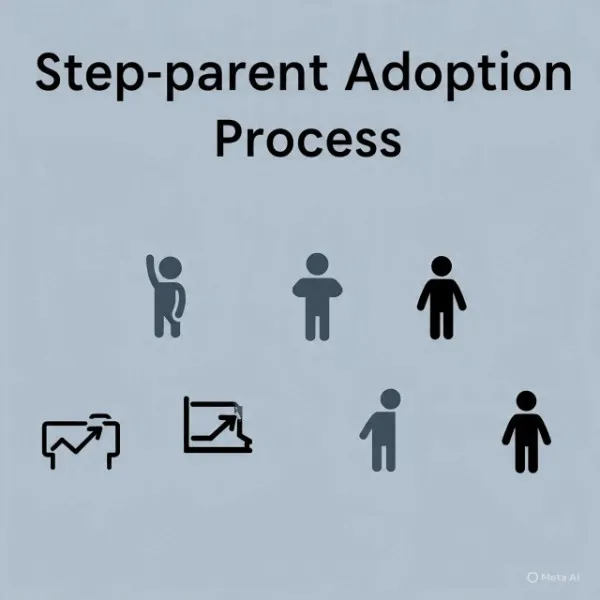9 Step-Parent Adoption Hacks That Make Your Journey Successful

When Sarah and David got married three years ago, she understood that she was gaining much more than just a husband. Along with her new partnership, she was also becoming a mother to David’s eight-year-old daughter, Emma, who played a significant role in David’s life.
What started as casual weekend visits, filled with laughter and bedtime stories, gradually turned into a deeper and more meaningful bond. As they spent more time together, Emma began to call Sarah “Mom.” This name came naturally to her and strengthened their connection day by day.
However, Sarah soon realized that, despite the love and emotional ties they had developed, she had no legal rights to make important decisions about Emma’s education, healthcare, or future.
This realization made the two consider Step-Parent Adoption. This legal process would officially make Sarah Emma’s mother and provide the stability their blended family needed.
Step-parent adoption is one of the common types of adoption in America. Though this type of adoption is gaining popularity, many families are still not ready to go through the process because of the legal complexities and emotional rollercoaster that come with it.
Whether you are just considering this important step or are already in the process, knowing the right strategies to adopt a stepson easily and fast.
What are the Steps of Step-Parent Adoption? Blazing the Trail to Your Future:
Step-Parent Adoption, as the name implies, is when a step-parent becomes willing to adopt their spouse’s child from a previous relationship. This creates a permanent legal relationship between the parent and child and also grants the step-parent full parental rights and responsibilities of the child.
This allows them to make significant decisions about medical care, education, and inheritance. The importance of Step-Parent Adoption goes far beyond just legal paperwork. It provides children with a sense of emotional security.
The adopted stepchild feels reassured that their care will remain stable, even if something happens to their biological parent. This legal arrangement in step-parent adoption helps to strengthen family dynamics and makes blended families feel completely united with each other.
However, adoption is a process with serious legal requirements that differ from state to state. You may be required to provide an adoption letter of consent, undergo a background check, perform home studies, and attend court hearings before you adopt the child.
It is very necessary to know what these requirements are earlier in the adoption process to help ensure a positive outcome. Each state has its own timelines, documentation requirements, and procedures that must be followed carefully to avoid delays or complications in your case.
Hold Open Family Discussions
The first thing you must do before stepping out to adopt your stepchild is to create time to have a conversation with everyone in your family. Discuss what the adoption means for each person, address any worries, and make sure the child understands and agrees to the decision.
The conversations should not be a one-time conversation. You must have it throughout the process, as it will help you create a safe environment for the children to share their feelings with you without fear of judgment.
Some children may worry about betraying their biological parents, while others might feel excited about having their relationship with their step-parent officially recognized.
If these talks become difficult or family members can’t communicate openly, think about getting help from a family counselor to promote positive discussions.
Do Extensive Research on Individual Needs Specified for Your State:
Laws governing step-parent adoption can vary quite a bit from state to state. Therefore, careful research is necessary for a smooth adoption process. The adoption process of step-children is not the same in all states.
For instance, while some states have simpler procedures for step-parent adoptions, others may have extensive paperwork requirements and longer wait times. It’s necessary that you research to understand your state’s requirements early on.
This research should include residency rules, required waiting periods after marriage, necessary paperwork, court filing procedures, and any related costs and fees. Understanding these details on time will undoubtedly prevent unnecessary delays and help you manage your time and budget better.
In addition, many states need specific forms to be filled out correctly. Small mistakes in these documents can lead to rejections and set you back in the process.
Get Written Consent from the Parent Who Is Not in Custody:
One of the most important parts of Step-Parent Adoption is getting consent from the non-custodial biological parent. They must willingly give up their parental rights for the adoption to go smoothly.
If that parent is involved in the child’s life, they may not want to give consent, fearing it will harm their relationship. Begin this sensitive conversation cautiously. Highlight that it is in the child’s best interest, and explain how the adoption will help them, rather than focusing on what the non-custodial parent might lose.
In some situations, mediation can assist everyone in discussing their concerns without conflict and reaching an agreement. However, if the non-custodial parent refuses consent, you may need to go to court to terminate their parental rights. You will need strong evidence and professional help to defend and support your case at this level.
Make Sure You Prepare Your Paperwork Well Ahead of Time:
There is so much paperwork involved in step-parent adoption, and adopting parents are expected to organize it and submit it according to court rules. To successfully navigate this process, you must start gathering all required documents from today.
The required documents include marriage certificates, birth certificates, divorce decrees, medical records, financial statements, background checks, and character reference letters from people who know your family well.
To ensure you don’t miss any, it will be nice if you create a file where you keep track of everything you’ve gathered. Make copies of all the required documents, and don’t forget to keep the original copies back into a secure place.
Neatly organizing your file and being on time, too, will not only make the legal process easier for you, but will make the court see that you are serious and ready to take on the responsibilities of being a legal parent.
Additionally, have in mind that each courts have specific requirements and certain documents they will need you to sign in front of a notary.
This may add extra time to the overall process, so it’s crucial to plan accordingly. By considering all these details, you can prevent last-minute rushes that might delay your case and ensure everything goes smoothly.
Common Errors Made During Step-Parent Adoption:
The Critical Error: Rushing the Process:
One of the most common mistakes prospective parents make during the adoption of a stepchild is to rush in without thorough preparation. The hurry usually comes from the utmost desire to officially and legally formalize family relationships.
However, this excitement can lead to several significant issues, such as delays, unexpected costs, and additional stress for everyone involved.
The truth is that rushing into adoption may cause you to forget the most important documents, neglect to have food conversations with your family about your intentions, or prepare for home study or court proceedings, all of which are important adoption process.
These careless errors can cause the court to reject your application, which will require more court appearances and increase the cost of adoption and the timelines.
In some cases, it may lead to complete denial of adoption, which you won’t want. Ironically, you may waste more time correcting the mistakes that resulted from your rushing than if you had approached the situation gradually from the beginning.
The Solution: Embrace Thorough Preparation:

Understand that thorough preparation can actually speed the process and save you from having the court process many times. Firstly, create a realistic timeline that allows enough time, from the first adoption step to the last, beginning several months before you intend to submit your adoption petition to the court.
Use this initial preparation time wisely by having open discussions with all family members about their feelings, thoughts, and expectations. Spend time researching the specific requirements that are mandatory in your state and court.
For financial planning, start saving money on time to cover all the necessary expenses that may arise as you go through the process. Additionally, it may also be best if you can concentrate on deepening your bond with the child above all things, especially if the relationship is still developing.
Tackle all the potential obstacles early before they overwhelm you. Although this methodical approach may seem time-consuming at first, it significantly increases the chances of a smooth and successful adoption process without delays or unexpected costs.
Effective preparation will make your journey smooth and save you and your family from future stress, and portray you as a serious adoptive parent.
Practical Advice for Achieving Long-term Success:
Financial planning is another proper step to take as you prepare to adopt, and it should be able to cover all the costs that are necessary in the adoption and sundry wide range of sundry factors beyond immediate legal costs.
As you prepare your budget, don’t forget to also budget other unforeseen expenses that could impact your family’s financial stability.
Create a detailed budget that includes obvious expenses like attorney fees and court costs, plus often-overlooked hidden costs. Mind you that these hidden costs are not punishment, but to cover other expenses that include lost wages from taking time off work for court appearances, potential travel costs for multiple court visits, or for document preparations, etc.
Also, verify if your employer offers adoption benefits, as many companies provide financial assistance or extra leave time for adoptive parents. Getting all these benefits can greatly reduce the overall financial burden of the adoption process.
Establishing a clear communication strategy is vital for managing the complex relationships involved in Step-Parent Adoption. Implementing respectful and clear communication patterns among everyone involved is key.
Constantly discuss your progress and progress with your partner and provide all the necessary updates to the child based on their age, as that will help them understand the situation and feel included.
Another important step you must take is to maintain open communication with the non-custodial parent when need be. Additionally, consider seeing a family counselor or mediator for help with difficult communications, especially with the birth parents whose rights may be terminated.
The reason is that effective communication can reduce misunderstandings and minimize any potential conflicts, because everyone’s concerns have been addressed as the journey progresses.
Effective management of your timeline requires that you balance the urgency and patiently navigate all the processes properly. Even if you find it delaying to wait till the finalization of your step-parent adoption, note that rushing can create unexpected challenges for you.
Create a realistic timeline considering your state-specific requirements and other potential delays you may see in the future.
Mind you that the normal timeline for step-parent adoption is from three to six months. Meanwhile, keep in mind that complex cases, including contested adoption, can take much time.
As you create your timeline, don’t forget to leave a buffer time that can cover times for unexpected delays. Use the waiting periods to strengthen your family relationships, gain more knowledge about adoption, and ensure that all your documents are completely selected and organized.
A strong support network is crucial for maintaining emotional stability and practical assistance during your Step-Parent Adoption journey. Build meaningful relationships with family members, friends, and professionals who can provide various types of support.
Seek a family therapists who specialize in adoption issues and legal professionals with expertise in family law to help you in times of need. Have multiple streams of support to ensure you get the help you need when challenges arise and help prevent feelings of isolation during this demanding process.
Having all your documents selected on time and properly arranged will help you manage the extensive paperwork involved in this type of adoption.
For security consciousness, I will advise that you create both physical and electronic filing systems that you can quickly access at any time, anywhere, along with backup copies to guard against loss or damage.
Sort all documents into different clear categories, such as court filings, personal papers, and necessary financial records. Have a full list of all necessary documents, so you can rest assured that nothing is overlooked.
You can store them on cloud backup services like Google Drive, Omega, which will help you protect them against technical issues like computer crashes.
High organization not only demonstrates professionalism to court staff and attorneys but also greatly reduces stress and saves time throughout the process.






